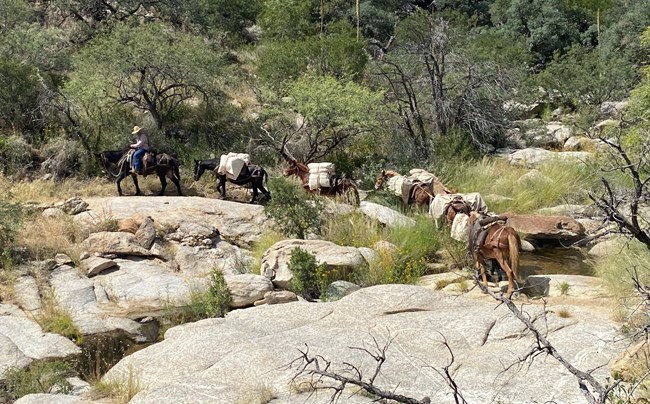
NPS Photo
Of the more than four hundred national parks in the National Park System, just over a hundred parks charge an entrance fee. The current Federal Lands Recreation Enhancement Act (FLREA) allows the National Park Service to collect and retain revenue and requires that fee revenue is used to enhance visitor experience. At least 80 percent of funding from recreation fees stays in the park where it is collected, and the other 20 percent is used to benefit parks that do not collect fees or parks which generate only a small amount of revenue.
What does that mean for our national parks and for you?
Using Fee Dollars in Parks
The Federal Lands Recreation Enhancement Act (FLREA) enables the National Park Service and other federal agencies to collect recreation fees and to retain fee revenues at the site collected in order to improve visitors’ experiences across the nation. The FLREA Project Spending dashboard below displays data on recreation fee revenue spending in national parks. The dashboard shows projects from fiscal years starting in 2020. The data helps identify:
- Where recreation fee revenue spending occurred
- Amounts obligated in each fiscal year by park unit or state
- How recreation fee revenue was used to enhance the visitor experience
Featured Projects
Pick a park on the map below to learn more about how they use recreation fees to benefit you.
The National Park Service is authorized to use entrance and recreation fees for a variety of items related to the visitor experience. Examples include:
-
Shiloh National Military Park in Mississippi and Tennessee installed three new restrooms on the Shiloh Battlefield.
-
Cabrillo National Monument in California provides increased custodial maintenance services at multiple locations in the park including the visitor center, park viewpoints, parking lots, and comfort stations.
-
The George Washington Memorial Parkway in Virginia completed restoration of the Netherlands Carillon, a tower with 53 bells located in the Arlington Ridge area.
-
Channel Islands National Park in California replaced their old dock on Anacapa Island so that visitors can now safely embark and disembark from boats.
-
Salem Maritime National Historic Site in Massachusetts replaced exterior doors to the Salem Visitor Center to provide universal accessibility and wider entrances.
-
Muir Woods National Monument in California constructed an accessible boardwalk on the Bohemian Grove Trail.
-
Mammoth Cave National Park in Kentucky has additional interpretative tours during increased visitation periods.
-
Joshua Tree National Park in California presents day and evening interpretive programs in their campgrounds.
Habitat Restoration (Wildlife Dependent Recreation)
-
Wind Cave National Park in South Dakota constructed boundary fencing to provide for a safe visitor experience to view bison and elk herds.
-
Dry Tortugas National Park in Florida restored their coral reef habitat to improve fishing and snorkeling opportunities.
Frequently Asked Questions About Entrance Fees
How are entrance fees determined for each park?
Since 2006, the National Park Service has had an entrance fee structure in place that simplifies and standardizes entrance fees across parks of similar types.
Why does the National Park Service charge entrance fees?
Entrance fees are an important source of revenue used to improve the visitor experience and recreation opportunities in national parks and on other federal lands.
The National Park Service is committed to enhancing the visitor experience, and fee revenue helps improve visitor facilities and infrastructure in parks.
How does buying an America the Beautiful pass support the parks?
The America the Beautiful National Parks and Federal Recreational Lands Pass Series is a collection of national interagency passes commonly used to cover entrance fees at national parks. The purchase of these passes funds projects that improve experiences and recreational opportunities for national park visitors.
Most of the revenue is used by the park where you purchase the pass. A portion also goes to the National Park Foundation Endowment and National Park Centennial Challenge Fund, which financially support projects and programs at National Park Service sites across the country.
People pay taxes; why do they have to pay to get into national parks?
Fees are an important source of revenue used to improve the visitor experience, including recreational opportunities, in national parks. Approximately 80 percent of the money from entrance fees remains in the park where it was collected. The remaining 20 percent is distributed to those parks that do not collect fees.
Why are some parks are going cashless?
Reducing cash collections allows the National Park Service to be better stewards of the fees collected from visitors. Cashless options reduce transaction times at busy entrance stations and decrease the risk of theft. Moving to a cashless system improves accountability and consistency, reduces chances of errors, and maximizes the funding available for critical projects and visitor services.
Each park that has completed the transition to cashless fee collection has an alternative option for visitors who are not able to pay with a credit or debit card. The specific arrangements vary by park, and park staff onsite will be able to assist.
Most parks that have converted to cashless fee collection have had an overwhelmingly positive experience.
Last updated: November 21, 2025
